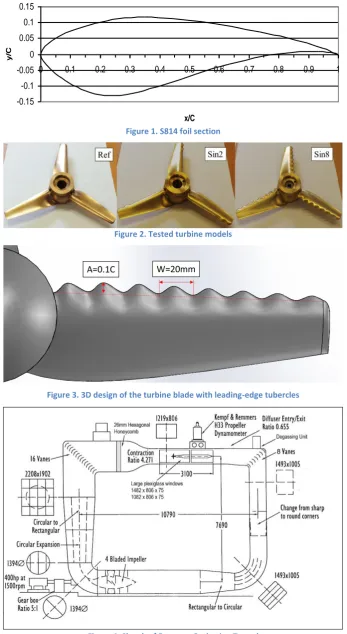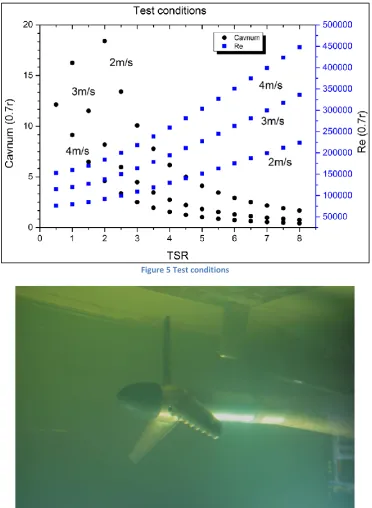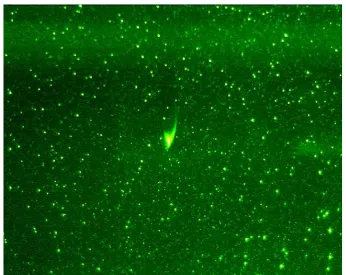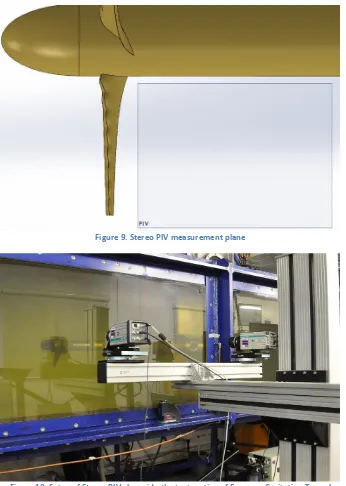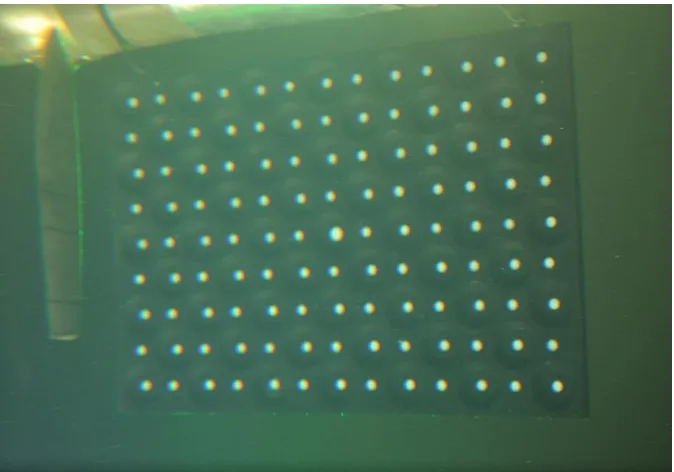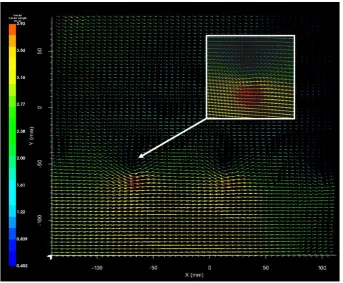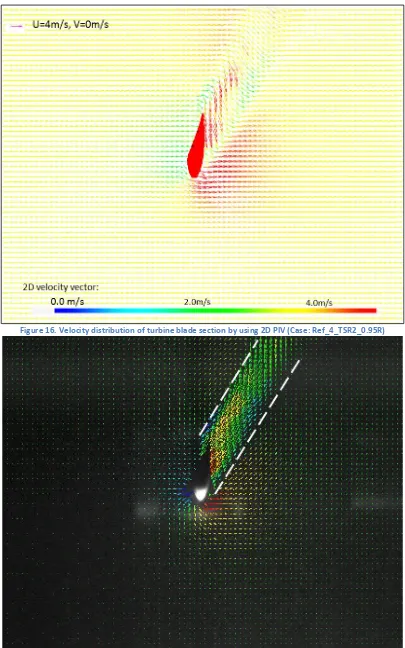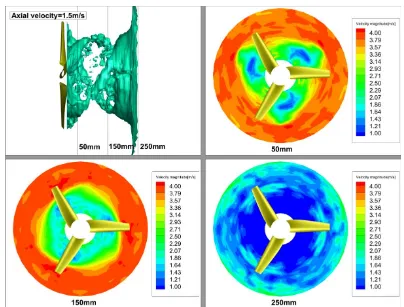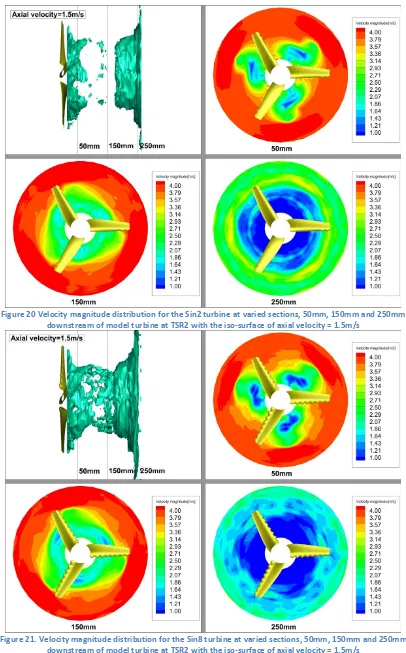1
Detailed flow measurement of the field around tidal turbines
1
with and without biomimetic leading-edge tubercles
2 3
Weichao Shi 1,2, Mehmet Atlar2, Rosemary Norman1
4 5
1 School of Marine Science and Technology, Newcastle University, UK 6
2 Department of Naval Architecture, Ocean & Marine Engineering, University of Strathclyde, 7
UK 8 9 10
Corresponding Author 11
Weichao Shi, w.shi6@ncl.ac.uk 12
School of Marine Science & Technology, Armstrong Building, Newcastle University 13
United Kingdom, NE1 7RU 14
Tel: 0044 (0)191 222 5067 15
Fax: 0044 (0)191 222 5491 16
2
Abstract: This paper focuses on implementing detailed flow measurement using advanced 19
Particle Image Velocimetry (PIV) system to investigate the flow mechanism of leading-edge 20
tubercles on tidal turbine blades. Two approaches have been applied: one is 2D PIV to map 21
the flow separation around the blade sections at different radial positions; and the other is 22
Stereo PIV to conduct a volumetric measurement in the wake field to reveal the tip vortex 23
development and also velocity distribution. The research presented in this paper further 24
demonstrates that the leading-edge tubercles can enable the flow to remain attached to the 25
blades and weaken the three dimensional effect which can lead to efficiency loss or the so-26
called “tip loss”. Based on these phenomena that have been observed and concluded from 27
the tests, the mechanism by which leading-edge tubercles can provide additional torque and 28
thrust for a tidal turbine has been explained within this paper. 29
Keywords: Particle Image Velocimetry (PIV), Tidal turbine, Blade design, Tubercles, 30
Biomimetic 31
3
1
Introduction
33
Flow control devices have been widely adopted to stimulate the performance of foils and 34
related devices; these include leading-edge slats, trail-edge flaps, winglets and vortex 35
generators, etc. However recently a biomimetic concept, the leading-edge tubercles on the 36
pectoral fins of humpback whales, has drawn attention [1, 2]. The tubercles first 37
demonstrated a delayed stall and also enhanced lift-to-drag ratios in an investigation in wind 38
tunnel tests for a pair of replica humpback whale flippers with and without leading-edge 39
tubercles [3, 4]. Following this, investigations both numerical and experimental in nature, 40
have looked at potential applications of leading-edge tubercles applied to air fans, wind 41
turbines, rudders, propellers and so on [5-10]. 42
Following a pioneering study that applied tubercles to a tidal turbine [11], recently the team 43
in the Emerson Cavitation Tunnel (ECT), Newcastle University has initiated a new blade design 44
study, by applying the concept to a tidal turbine [12-14]. Initially a study was conducted into 45
a 3D hydrofoil with a tidal turbine chord length distribution but a constant pitch angle, which 46
demonstrated the increased lift after the stall angle and the enhanced maximum lift-to-drag 47
ratio [12]. Using computational fluid dynamics analysis, it was also shown that the three 48
dimensional effect, which causes spanwise flow, can be reduced by the contra rotating vortex 49
fence generated by the tubercles [15]. 50
With confidence built from the hydrofoil study, the design was applied to a scaled turbine 51
model with different levels of tubercle coverage. The scaled model tests were conducted for 52
a number of different purposes, including hydrodynamic performance analysis, cavitation 53
observation and noise performance. It has been proved that the hydrodynamic performance 54
of the turbine can be enhanced in the low tip speed ratio region without lowering the 55
maximum power coefficient, which will enable the turbine to start at lower flow velocities 56
[13]. The tubercles can also help in restraining the cavitation region and hence lowering the 57
noise level [14]. With these benefits, a quiet and quick reacting turbine design can be 58
established. 59
However, the reasons why such benefits can be introduced by this tubercle concept have 60
been discussed and argued by many researchers but not conclusively; these arguments 61
include compartmentalization, vortex lift, varying the effective angle of attack and boundary 62
layer momentum exchange [6]. Therefore, to further investigate the flow mechanism behind 63
the tubercle function, a set of detailed flow measurements have been conducted. The test 64
setup and results are presented and discussed in the following sections. Particle Image 65
Velocimetry (PIV) technology was used to measure the velocity distribution and two different 66
setups were employed, one for mapping of the flow separation and the other one for 67
4
2
Description of the tested model
69
The reference turbine was chosen to be a model that was designed, tested and numerically 70
modelled during a previous project [16, 17]. Based on this model, leading-edge tubercles were 71
applied to the blades. The blade section of the reference turbine used the NREL S814 foil 72
section, as shown in Figure 1. The main particulars for this 400mm diameter model turbine 73
are shown in Table 1. 74
Three pitch-adjustable turbine models with different leading-edge profiles were 75
manufactured by Centrum Techniki Okrętowej S.A. (CTO, Gdansk), as shown in Figure 2. “Ref” 76
refers to the turbine model with a smooth leading edge; while “Sin2” refers to the one with 77
two leading-edge tubercles at the tip; and the one with eight leading-edge tubercles is named 78
“Sin8”. The sinusoidal leading-edge profile was developed as shown in Figure 3. The 79
amplitude (A) of the sinusoidal tubercles was equal to 10% of the local chord length (C) while 80
eight tubercles were evenly distributed along the radius with the wavelength (W) equal to 81
20mm. The profile of the leading tubercles was as represented by Equation 1. 82
𝐻 =𝐴 2𝑐𝑜𝑠 [
2𝜋
𝑊 (𝑟 − 40) − 𝜋] + 𝐴 2
Equation 1
Where H is the height of the leading-edge profile relative to the reference one which is the 83
smooth leading-edge profile. 84
3
Experimental setup and approach
85
3.1 Description of the Emerson Cavitation Tunnel
86
The three tidal turbine models were tested in the Emerson Cavitation Tunnel (ECT) at 87
Newcastle University. A sketch of the tunnel is shown in Figure 4. The tunnel is a medium size 88
propeller cavitation tunnel with a measuring section of 1219mm × 806mm (width × height). 89
The speed of the tunnel water varies between 0.5 and 8 m/s. Full details of the ECT can be 90
found in [18]. 91
3.2 Turbine control and force measurement
92
The turbine was mounted on a vertically driven dynamometer, Kempf & Remmers H33, 93
designed to measure the thrust and torque of a propeller or turbine. A 64kW DC motor is 94
mounted on top of the dynamometer to control the rotational speed of the turbine. The setup 95
is shown in Figure 6. 96
The rotational speed is controlled by the motor to achieve the desired Tip Speed Ratio (TSR) 97
which can be calculated using Equation 2. During the model tests, the torque and thrust of 98
the turbine were measured and from these measurements the power coefficient (Cp) and the 99
thrust coefficient (CT) can be derived by using Equation 3 and Equation 4 respectively:
5
𝑇𝑆𝑅 =𝜔𝑟 𝑉
Equation 2
𝐶𝑝 =1 𝑄𝜔 2 𝜌𝐴𝑇𝑉3
Equation 3
𝐶𝑇 =1 𝑇 2 𝜌𝐴𝑇𝑉2
Equation 4
where Q is the torque of the turbine, in Nm; T is the thrust, in N; 𝜔 is the rotational speed, in 101
rad/s; AT is the swept area of the turbine and equals D2/4, m2; 𝜌 is the tunnel water density,
102
in kg/m3; V is the incoming velocity, in m/s, D is the turbine diameter, in m.
103
As the performance of the turbine is strongly dependent on the Reynolds number and the 104
cavitation number, these two non-dimensional numbers at 0.7 radius of the turbine blade, 105
𝑅𝑒0.7𝑟 and 𝐶𝑎𝑣0.7𝑟 were monitored and can be derived from Equation 5 and Equation 6
106
respectively. 107
𝑅𝑒0.7𝑟 =
𝐶0.7𝑟√(𝑉2+ (0.7𝜔𝑟)2 ν
Equation 5
𝐶𝑎𝑣0.7𝑟 = 1 𝑃0.7𝑟− 𝑃𝑣 2 𝜌√(𝑉2+ (0.7𝜔𝑟)2
Equation 6
where 𝐶0.7𝑟is the chord length of the turbine at 0.7 radius, m; ν is the kinematic viscosity of
108
the water, m²/s; 𝑃0.7𝑟 is the static pressure at the upper 0.7 radius of the turbine, Pa; 𝑃𝑣 is the
109
vapour pressure of the water, Pa. 110
Throughout the test campaign, the incoming flow velocity of the tunnel was fixed and the 111
rotational speed was varied to achieve the required TSR. The tests were conducted according 112
to the test matrix shown in Table 2. The test conditions are also shown in graphical format in 113
Figure 5. At high Reynolds numbers, due to the increased incoming velocity, cavitation 114
number was reduced and hence cavitation might occur at the turbine blades. Taking 115
advantage of the pitch adjustable design, three different pitch angles of the turbine blades 116
were tested. Details of the hydrodynamic performance, cavitation observation and noise 117
measurement, have been presented in the papers [13, 14]. 118
6
3.3 2D/ Stereo PIV system and calibration
120
The PIV system used in the ECT is a Dantec Dynamics Ltd system and a summary of its 121
technical details is given in Table 3. In this test, both 2D PIV and SPIV measurements were 122
conducted. 123
3.3.1 Setup of 2D PIV 124
Within this experiment, 2D PIV measurement was carried out for the purpose of measuring 125
the velocity distribution within the planar sections at different radii, as shown in Figure 7. The 126
two dimensional velocity vector in the plane can be measured in this way. The flow separation 127
area can be mapped and compared after the test so that the differences of flow separation 128
influenced by the leading-edge tubercles can be revealed. 129
The flow field was illuminated by the laser system and the highly seeded flow field was filmed 130
using a high-speed CCD camera which was set perpendicular to the light sheet. A sample 131
image is shown in Figure 8. 132
3.3.2 Setup of Stereo PIV 133
Following the 2D PIV measurement, a stereo PIV measurement was conducted to measure 134
the three velocity components in a plane after the turbine. The measurement plane of the 135
SPIV is shown in Figure 9. 136
The stereo PIV used the same laser system to illuminate the seeded flow field. However two 137
high-speed cameras were used to capture the image from different angles. The setup of the 138
Stereo PIV system in the ECT is shown in Figure 10. Typical images from the two cameras are 139
shown in Figure 11. 140
The use of the SPIV needs special calibration for the two cameras, which involves a multi-level 141
270x190mm calibration target. In order to calibrate the SPIV system, the calibration target 142
had to be installed in the measurement plane, as shown in Figure 12. The two cameras viewed 143
the calibration target from the same side but different angles. The calibration result is shown 144
in Figure 13, which also shows the camera positions. 145
3.4 Phase averaging and Image processing
146
Throughout the measurements of 2D PIV and stereo PIV, 100 double frame image pairs 147
needed to be captured, analysed and averaged to achieve a time-averaged velocity 148
distribution. In order to capture these images always at the same azimuth position of the 149
turbine, the camera and the laser were controlled and synchronized by a cyclic synchronizer. 150
This cyclic synchronizer is based on an encoder on the motor and a CompactDAQ system from 151
National Instruments coded in LabVIEW, which has the capability of triggering the camera at 152
the desired angular positions. However, the rotational rate of the turbine needed to have a 153
minimum value of 350rpm to enable the system. 154
In order to analyse the images and hence to determine the flow velocities, adaptive PIV 155
analysis was used for the 2D images from each camera. Afterwards, the results of these 100 156
7
calibration results and the 2D PIV data, finally the SPIV results with three component velocity 158
could be achieved, as shown in Figure 14, and also the detailed structure of the tip vortex 159
could be revealed. 160
4
Testing conditions
161
Based on the hydrodynamic performance tests, the performance of the three turbines at 162
three different pitch angles, 0⁰, +4⁰ and +8⁰, was evaluated in the first stage, which provided 163
the guidelines for the PIV measurement. According to the test result at 2m/s, shown in Figure 164
15 , even though +8⁰ pitch angle has a slightly lower power coefficient (Cp) compared to +4⁰, 165
it has much lower thrust (CT/10) and also a better starting performance in the lower range of
166
TSRs. Therefore the +8⁰ pitch angle was selected to be investigated in this paper for the PIV 167
test. 168
The PIV test was conducted at three different TSRs in order to thoroughly understand the 169
effect caused by the leading-edge tubercles while the turbine was operating under different 170
conditions. This test needed to consider not only the minimum RPM requirement but also the 171
impact of blade cavitation, since cavitation bubbles could greatly deteriorate the image 172
quality. Therefore, the following three typical working conditions were selected. 173
1. Stall condition (TSR=2): Tidal turbine will experience this condition while accelerating 174
up to the optimum working condition (TSR=4). However under this stall condition, 175
flow separation could occur. The most significant improvement resulting from the 176
leading-edge tubercles has been found under this condition. During the test, an 177
incoming velocity of 4m/s and a rotational speed of 382rpm were used. The 178
performance comparison of Cp and CT/10 is presented in Table 4.
179
2. Optimum working condition (TSR=4): This is the optimum condition under which the 180
turbine would operate in order to maximise the power generation. This is also the 181
turbine’s design condition. Most turbines will maintain this TSR to achieve the 182
maximum power coefficient. During the test, an incoming velocity of 3m/s and 183
rotational speed of 573rpm were set. 184
3. Overspeed condition (TSR=5): This is the condition in which the turbine is working 185
beyond the optimum TSR. This is often considered to be the overspeed condition that 186
might be harmful for the generator and gearbox. However there are some turbines 187
designed to operate under this condition since the higher rotational speed will result 188
in better generator performance. More stable performance can be expected 189
compared to the optimum working conditions under which the turbine might suffer 190
from stall due to the natural flow fluctuation caused by waves or turbulence. During 191
the test, an incoming velocity of 3m/s and rotational speed of 716rpm were set. 192
The performance comparison of the above three conditions has been summarised in Table 4. 193
It can be noticed that at high TSR the increment in Cp for the turbine with tubercles is related 194
to a rather significant increase in CT. While at TSR=2, the increase in Cp is much higher than
195
the increase in CT, with the increase of TSR the inflow angle will be reduced inducing more
196
thrust while with the decrease of TSR the opposite will be true for the inflow angle, i.e. 197
8
5
Result analysis
199
5.1 Visualizing the planar section using 2D PIV
200
For the purpose of mapping the flow separation region around the turbine blade, 2D PIV 201
measurement was conducted for the above three turbines in the selected three typical 202
conditions. All of the cases are referred to in the form “Model_Velocity_TSR_Position”, i.e. 203
“Ref_4_TSR2_0.95R”. 204
The measurement result of 2D velocity distribution of the reference turbine at 0.95r under 205
4m/s with TSR=2 is presented in Figure 16 with the reference vector (U=4m/s, V=0m/s) 206
displayed at the top left corner. It shows typical flow separation behind the turbine blades. 207
However, in order to highlight the flow separation area behind the blade, the following results 208
are presented in a form shown in Figure 17 with the reference vector being subtracted and 209
the actual image being plotted in the background. As it can be seen, the turbine is suffering 210
from significant flow separation after the blade, as marked between the white dashed lines. 211
With this methodology, the flow separation area can be clearly mapped and compared. 212
All of the measurement results under TSR=2 are presented using the above method, as shown 213
in Table 5. In order to clearly compare the flow separation area, the vorticity Z distribution is 214
plotted in Table 6. In-depth analysis and a comparison between the performance of the three 215
different turbines is shown in Table 4 indicating the dramatic difference in the stall condition, 216
under which the flow around the turbine is also significantly changed by the tubercles. It can 217
be clearly seen in Table 5 that the leading-edge tubercles can help the flow to be more 218
attached to the turbine blade at various radial positions particularly from 0.8R to 0.95R. This 219
phenomenon has proved the beneficial effect of the leading-edge tubercles for tidal turbines, 220
especially under the stall condition is because of the more attached flow. 221
At sections towards the hub, the flow separation is gradually reduced due to the decreasing 222
angle of attack. However the flow separation observed in the mid span region of the Sin8 223
turbine blades might be slightly larger from 0.6R to 0.45R as the result of the change in the 224
angle of attack. This is because, at this region, the tubercles operating at unfavourable angles 225
of attack and triggering a leading-edge flow separation due to the high speed flow induced by 226
the tubercles. In contrast the reference turbine without tubercles will generate trailing-edge 227
flow separation. 228
For the other two conditions, TSR=4 and TSR=5, the flow separation phenomenon has not 229
been clearly observed since the angles of attack are lower than the stall angle; therefore the 230
measurement results have been presented as a database for future research in Appendix A, 231
Table 7 at TSR=4 and Table 8 at TSR=5. 232
5.2 Mapping the volumetric flow field using SPIV
233
By using SPIV, three velocity components: the axial velocity, the radial velocity and the 234
tangential velocity can be visualised in the measuring plane downstream of the turbine blades 235
along with the resultant vorticity distribution. With the aid of the phase locking and averaging 236
technique discussed in Section 3.4, SPIV measurements were conducted every 10° of angular 237
9
different positions, a volumetric flow field can be achieved to resolve the turbine’s wake field, 239
as shown in Figure 18. In Figure 19 to Figure 27, the velocity magnitude distributions in the 240
wake field downstream of these three different turbines under various conditions have been 241
presented. In the following sections, detailed analysis and discussion are presented with 242
regard to each of the individual conditions. Three sections, which are consecutively 50mm, 243
150mm and 250mm downstream of the turbine, were extracted and the velocity magnitude 244
plotted at those sections. 245
5.2.1 Condition 1: Stall condition, TSR=2 246
In Figure 19 to Figure 21, the velocity magnitude distribution under the stall condition has 247
been presented together with the iso-surface of axial velocity=1.5m/s. As discussed in Section 248
5.1, severe flow separation occurred under this condition. Because of the flow separation that 249
the turbines suffered, in the wake field the flow is much more turbulent compared to the 250
other conditions. Also, because of the low tip speed ratio, the tip vortex structure is not very 251
clearly seen from the iso-surface. 252
It can be noticed that the tail of iso-surface plot for the Sin2 case is slightly behind the other 253
two turbine cases and the associated iso-surface appears to be more intermittent compared 254
to the other two cases and this results in a significant difference at section d=250mm. This is 255
because of the fact that the flow is mixed quicker and hence the velocity deficit in the mid-256
span can be recovered faster by the Sin2 turbine compared to other two turbine cases. It can 257
also be seen for section d=150mm the flow of Sin2 in the mid-span region has a higher speed 258
compared to the other two turbine cases. 259
By extracting the iso-surface pair of radial velocity= +/-0.5m/s in Figure 28, the tip vortex can 260
be revealed which is rolling from the pressure side to the suction side and disappearing in the 261
wake. The iso-surface for the turbine Ref is wider and smoother than that for the other two 262
turbines. For the case Sin8 especially, the iso-surface is quite narrow but extends for a longer 263
distance. This trend can also be seen in which shows the iso-surface of the vorticity (tangential) 264
= 100. This component of vorticity results from the axial velocity and the radial velocity and 265
also reveals the tip vortex. As it can be seen, the iso-surface of the Sin8 case is longer but 266
narrower. This indicates that the tip vortex of the turbines with tubercles under the stall 267
condition is stronger but cannot influence as large an area of the blade because of the contra-268
rotating vortex fences created in between the tubercles. This phenomenon was also reported 269
in a previous paper which claimed that these contra-rotating vortices generated by the 270
tubercles help to reduce the blade from suffering further lift loss caused by the tip vortex [15]. 271
On the other hand, some strong vortex development around 0.6R region can also be observed 272
across the three turbines in Figure 29. This vortex development can be related to the flow 273
separation in this region. At this TSR, the angles of attack along the radii varied significantly, 274
which was also observed in the flow separation investigations, and hence resulting in 275
difference of the vorticity distribution along the span. 276
5.2.2 Condition 2: Optimum working condition, TSR=4 277
In Figure 22 to Figure 24, the velocity magnitude distribution, while the turbines are operating 278
at the optimum power coefficient condition, has been presented together with the iso-279
10
the tip vortex. By comparing these iso-surfaces, it can be seen that the strength of these tip 281
vortices is gradually weakened by the tubercles as the iso-surface gradually gets shorter with 282
the increase in the number of tubercles. 283
On the other hand, the velocity deficit behind the turbine increases with the numbers of 284
tubercles, as it can be seen in the section plots. This is due to the higher induction factor that 285
is generated by the turbine with tubercles. This can also be seen in Table 4 where the force 286
measurement, represented by the thrust coefficient, is 4.6% and 7.7% higher for the Sin2 and 287
Sin8 cases, respectively, relative to the reference turbine and the power coefficient is similarly 288
2.2% and 4.3% higher. 289
5.2.3 Condition 3: Overspeed condition, TSR=5 290
A similar trend to Condition 2 can also be observed in Condition 3 in Figure 25 to Figure 27, 291
where the turbine is working under the overspeed condition. The iso-surface also gradually 292
shortens with the increase in the number of tubercles, which shows the weakened tip vortex 293
resulting from the tubercles. The same trend is also seen in terms of the increased velocity 294
deficit from the tubercles and this is even more pronounced compared to Condition 2; the 295
thrust coefficient being 4.0% and 9.2% higher and the power coefficient 1.6% and 4.0% higher 296
for the Sin2 and Sin8 cases compared to the reference turbine, as seen in Table 4. 297
6
Conclusions
298
Following on from the previous experimental studies of the hydrodynamic performance and 299
the cavitation and noise performance of tidal turbines with biomimetic leading-edge tubercle 300
designs, this paper focuses on detailed flow measurement using both 2D PIV and stereo PIV 301
in order to investigate the flow mechanisms around the turbine with the assumption of steady 302
flow. 303
The measurements were conducted in three typical operating conditions: 1. Stall condition 304
(TSR=2), 2. Optimum working condition (TSR=4) and 3. Overspeed condition (TSR=5), and the 305
findings have been concluded as follows: 306
1. With the aid of 2D PIV, the flow separation around the blade sections at every 10 mm 307
radius has been mapped and compared under all of the selected conditions. Under 308
the Stall condition, while all turbine blades suffer from severe flow separation, the 309
turbines with leading-edge tubercles can help to maintain the flow to be more 310
attached to the blade surface at certain positions, which provides the turbine 311
additional torque for starting. In the other two conditions, since the flow does not 312
separate from the blades, there is no clear difference seen. 313
2. By using SPIV, a volumetric measurement has been conducted and the flow structure 314
in the wake field with three velocity components has been obtained. This reveals the 315
flow structure downstream of the turbine. It can be clearly seen that turbines with 316
tubercles can induce a higher induction factor, which results in lower velocity in the 317
wake field and higher power and thrust coefficients. This effect is positively related to 318
11
3. Also it can be noticed in the SPIV measurement that the tip vortex can be weakened 320
and its axial trajectory is shortened by the tubercles in the optimum working condition 321
and the overspeed condition. Therefore, the three dimensional effect can be reduced 322
by the tubercles. Under the stall condition, the tubercles help the turbine to confine 323
the vortex at the tip region and isolate it from influencing larger areas of the blades 324
which also weakens the three dimensional effect. 325
One should be born in mind that the study presented in this paper and resulting conclusions 326
are based on the steady state experimental investigations conducted at the model scale and 327
analyses of the associated data. However, in real world with the full-scale applications, the 328
important issue of the scale effect and that of the unsteady or transient flow effects (e.g. stall 329
and over speeding) will require further investigations for the through exploitation of the 330
tubercle applications on tidal turbine blades.” 331
Acknowledgement
332
This research is funded by the School of Marine Science and Technology, Newcastle University 333
and the China Scholarship Council. The financial support obtained from both establishments 334
is gratefully acknowledged. The Authors would also like to thank all the team members in the 335
Emerson Cavitation Tunnel for their help in testing and sharing their knowledge. 336
Reference
337
[1] F.E. Fish, J.M. Battle, Hydrodynamic design of the humpback whale flipper, Journal of 338
Morphology 225:51-60 (1996). 339
[2] F.E. Fish, P.W. Weber, M.M. Murray, L.E. Howle, The tubercles on humpback whales' 340
flippers: application of bio-inspired technology, Integrative and comparative biology 51(1) 341
(2011) 203-13. 342
[3] D.S. Miklosovic, M.M. Murray, L.E. Howle, Experimental evaluation of sinusoidal leading 343
edges, J Aircraft 44(4) (2007) 1404-1408. 344
[4] D.S. Miklosovic, M.M. Murray, L.E. Howle, F.E. Fish, Leading-edge tubercles delay stall on 345
humpback whale (Megaptera novaeangliae) flippers, Phys Fluids 16(5) (2004) L39-L42. 346
[5] I.H. Ibrahim, T.H. New, Tubercle modifications in marine propeller blades, 10th Pacific 347
Symposium on Flow Visualization and Image Processing, Naples, Italy, 2015. 348
[6] M.D. Bolzon, R.M. Kelso, M. Arjomandi, Tubercles and Their Applications, Journal of 349
Aerospace Engineering 29(1) (2016) 04015013. 350
[7] P.W. Weber, L.E. Howle, M.M. Murray, Lift, Drag, and Cavitation Onset On Rudders With 351
Leading-edge Tubercles, Mar Technol Sname N 47(1) (2010) 27-36. 352
[8] M.J. Stanway, Hydrodynamic effects of leading-edge tubercles on control surfaces and in 353
flapping foil propulsion, Department of Mechanical Engineering, Massachusetts Institute of 354
12
[9] L.E. Howle, Whalepower wenvor blade, Bellequant Engineering, PLLC, 2009. 356
[10] A. Corsini, G. Delibra, A.G. Sheard, On the Role of Leading-Edge Bumps in the Control of 357
Stall Onset in Axial Fan Blades, J Fluid Eng-T Asme 135(8) (2013) 081104-081104. 358
[11] T. Gruber, M.M. Murray, D.W. Fredriksson, Effect of humpback whale inspired tubercles 359
on marine tidal turbine blades, ASME 2011 International Mechanical Engineering Congress 360
and Exposition, American Society of Mechanical Engineers, 2011, pp. 851-857. 361
[12] W. Shi, M. Atlar, R. Norman, B. Aktas, S. Turkmen, Numerical optimization and 362
experimental validation for a tidal turbine blade with leading-edge tubercles, Renewable 363
Energy 96 (2016) 42-55. 364
[13] W. Shi, R. Rosli, M. Atlar, R. Norman, D. Wang, W. Yang, Hydrodynamic performance 365
evaluation of a tidal turbine with leading-edge tubercles, Ocean Engineering 117 (2016) 246-366
253. 367
[14] W. Shi, M. Atlar, R. Rosli, B. Aktas, R. Norman, Cavitation observations and noise 368
measurements of horizontal axis tidal turbines with biomimetic blade leading-edge designs, 369
Ocean Engineering 121 (2016) 143-155. 370
[15] W. Shi, M. Atlar, K. Seo, R. Norman, R. Rosli, Numerical simulation of a tidal turbine based 371
hydrofoil with leading-edge tubercles, 35th International Conference on Ocean, Offshore and 372
Arctic Engineering, OMAE2016, Proceedings of the ASME 2016, Busan, Korea, 2016. 373
[16] D. Wang, M. Atlar, R. Sampson, An experimental investigation on cavitation, noise, and 374
slipstream characteristics of ocean stream turbines, P I Mech Eng a-J Pow 221(A2) (2007) 219-375
231. 376
[17] W. Shi, D. Wang, M. Atlar, K.-c. Seo, Flow separation impacts on the hydrodynamic 377
performance analysis of a marine current turbine using CFD, Proceedings of the Institution of 378
Mechanical Engineers, Part A: Journal of Power and Energy 227(8) (2013) 833–846. 379
[18] M. Atlar, Recent upgrading of marine testing facilities at Newcastle University, AMT’11, 380
Newcastle upon Tyne, UK, 2011, pp. 4-6. 381
13 383
Figure 1. S814 foil section 384
385
Figure 2. Tested turbine models 386
[image:13.595.124.472.74.709.2]387
Figure 3. 3D design of the turbine blade with leading-edge tubercles 388
389
Figure 4. Sketch of Emerson Cavitation Tunnel 390
S814 Airfoil
-0.15 -0.1 -0.05 0 0.05 0.1 0.15
0 0.1 0.2 0.3 0.4 0.5 0.6 0.7 0.8 0.9 1
x/C
y
[image:13.595.127.468.464.704.2]14 391
Figure 5 Test conditions 392
393
394
Figure 6. Model turbine mounted on the dynamometer and being tested in Emerson Cavitation Tunnel 395
15 397
Figure 7. Radial positions of 2D PIV measurement planes 398
399
400
Figure 8. Sample image of 2D PIV 401
[image:15.595.124.471.433.708.2]16 403
Figure 9. Stereo PIV measurement plane 404
405
406
Figure 10. Setup of Stereo PIV alongside the test section of Emerson Cavitation Tunnel 407
408
409
Figure 11. Typical stereo PIV Images from two different cameras shooting from different perspective angles 410
[image:16.595.128.468.572.705.2]17 412
Figure 12. Calibration target for stereo PIV system located at downstream of model turbine 413
414
[image:17.595.131.468.70.306.2]415
Figure 13. Calibration result of stereo PIV 416
18 418
Figure 14. Stereo PIV result with a detailed tip vortex structure 419
420
421
Figure 15. Performance of Reference turbine in terms of power (Cp) and thrust (CT) coefficients
422
[image:18.595.128.470.372.620.2]19 424
Figure 16. Velocity distribution of turbine blade section by using 2D PIV (Case: Ref_4_TSR2_0.95R) 425
426
20 428
Figure 18. Volumetric flow field description for stereo PIV measurements 429
430
431
Figure 19. Velocity magnitude distribution for the reference turbine at varied sections, 50mm, 150mm and 250mm 432
downstream of model turbine at TSR2 with the iso-surface of axial velocity = 1.5m/s 433
[image:20.595.94.498.373.680.2]21 435
Figure 20 Velocity magnitude distribution for the Sin2 turbine at varied sections, 50mm, 150mm and 250mm 436
downstream of model turbine at TSR2 with the iso-surface of axial velocity = 1.5m/s 437
[image:21.595.94.500.67.720.2]438
Figure 21. Velocity magnitude distribution for the Sin8 turbine at varied sections, 50mm, 150mm and 250mm 439
22 441
Figure 22. Velocity magnitude distribution for the reference turbine at varied sections, 50mm, 150mm and 250mm 442
downstream of model turbine at TSR4 with the iso-surface of axial velocity = 3.3m/s 443
[image:22.595.71.506.68.718.2]444
Figure 23. Velocity magnitude distribution for the Sin2 turbine at varied sections, 50mm, 150mm and 250mm 445
23 447
Figure 24. Velocity magnitude distribution for the Sin8 turbine at varied sections, 50mm, 150mm and 250mm 448
downstream of model turbine at TSR4 with the iso-surface of axial velocity = 3.3m/s 449
[image:23.595.93.499.70.703.2]450
Figure 25. Velocity magnitude distribution for the reference turbine at varied sections, 50mm, 150mm and 250mm 451
24 453
Figure 26. Velocity magnitude distribution for the Sin2 turbine at varied sections, 50mm, 150mm and 250mm 454
downstream of model turbine at TSR5 with the iso-surface of axial velocity = 3.3m/s 455
[image:24.595.93.500.68.713.2]456
Figure 27. Velocity magnitude distribution for the Sin8 turbine at varied sections, 50mm, 150mm and 250mm the turbine 457
at TSR5 with the iso-surface of axial velocity = 3.3m/s 458
25 460
Figure 28. Iso-surface pair of radial velocity = +/-0.5m/s at TSR2 (Left: Ref; Middle: Sin2; Right: Sin8) 461
462
[image:25.595.73.524.72.206.2]463
26
Table 1. Main particulars of tidal stream turbine model 465
r/R 0.2 0.3 0.4 0.5 0.6 0.7 0.8 0.9 1
Chord length(mm) 64.35 60.06 55.76 51.47 47.18 42.88 38.59 34.29 30
Pitch angle (deg) 27 15 7.5 4 2 0.5 -0.4 -1.3 -2
Hub radius (0.2R) = 40mm; Same section profile, S814, along the radial direction
466
Table 2 Test matrix 467
V TSR RPM Pitch angle Tunnel
pressure
Cav Re
(m/s) (o) (mmhg) (0.7r) (0.7r)
2 0.5 ~ 8 47 ~ 763 0 850 48.534 ~ 1.684 0.76E+05 ~ 2.24E+05
2 0.5 ~ 8 47 ~ 763 +4 850 48.534 ~ 1.684 0.76E+05 ~ 2.24E+05
2 0.5 ~ 8 47 ~ 763 +8 850 48.534 ~ 1.684 0.76E+05 ~ 2.24E+05
3 0.5 ~ 8 71 ~ 1145 0 850 21.571 ~ 0.748 1.15E+05 ~ 3.36E+05
3 0.5 ~ 8 71 ~ 1145 +4 850 21.571 ~ 0.748 1.15E+05 ~ 3.36E+05
3 0.5 ~ 8 71 ~ 1145 +8 850 21.571 ~ 0.748 1.15E+05 ~ 3.36E+05
4 0.5 ~ 8 95 ~ 1527 0 850 12.134 ~ 0.421 1.53E+05 ~ 4.48E+05
4 0.5 ~ 8 95 ~ 1527 +4 850 12.134 ~ 0.421 1.53E+05 ~ 4.48E+05
4 0.5 ~ 8 95 ~ 1527 +8 850 12.134 ~ 0.421 1.53E+05 ~ 4.48E+05
468
Table 3. Technical specifications of Particle Image Velocity (PIV) system 469
Laser NewWave Pegasus
Light sheet optics 80x70 high power Nd:YAG light sheet series
Synchronizer NI PCI-6601 timer board
Camera NanoSense MK III
Sensor size 1280x1024 pixels
Maximum capture frequency 1000Hz
Maximum images 3300
Calibration target Multi-level 270x190 mm, 2nd level -4
Seeding particles Talisman 30 white 110 plastic powder
[image:26.595.35.527.74.612.2]470
Table 4. Measured hydrodynamic performance data of model turbines in the selected PIV testing conditions 471
Power coefficient (Cp)
Conditions Ref Sin2 (Increment ratio) Sin8 (Increment ratio)
TSR2_4 17.1% 19.3% 12.4% 19.2% 12.1%
TSR4_3 46.4% 47.4% 2.2% 48.3% 4.3%
TSR5_3 44.4% 45.1% 1.6% 46.1% 4.0%
Thrust coefficient (CT/10)
Conditions Ref Sin2 (Increment ratio) Sin8 (Increment ratio)
TSR2_4 6.0% 6.1% 1.4% 6.4% 6.4%
TSR4_3 8.6% 8.9% 4.6% 9.2% 7.7%
TSR5_3 8.6% 8.9% 4.0% 9.4% 9.2%
27
Table 5. 2D PIV measurement results of turbines at different radial positions (at TSR=2) 474
Ref_4_TSR2_1.0R Sin2_4_TSR2_1.0R Sin8_4_TSR2_1.0R
Ref_4_TSR2_0.95R Sin2_4_TSR2_0.95R Sin8_4_TSR2_0.95R
Ref_4_TSR2_0.9R Sin2_4_TSR2_0.9R Sin8_4_TSR2_0.9R
Ref_4_TSR2_0.85R Sin2_4_TSR2_0.85R Sin8_4_TSR2_0.85R
28
Ref_4_TSR2_0.75R Sin2_4_TSR2_0.75R Sin8_4_TSR2_0.75R
Ref_4_TSR2_0.7R Sin2_4_TSR2_0.7R Sin8_4_TSR2_0.7R
Ref_4_TSR2_0.65R Sin2_4_TSR2_0.65R Sin8_4_TSR2_0.65R
Ref_4_TSR2_0.6R Sin2_4_TSR2_0.6R Sin8_4_TSR2_0.6R
29
Ref_4_TSR2_0.5R Sin2_4_TSR2_0.5R Sin8_4_TSR2_0.5R
Ref_4_TSR2_0.45R Sin2_4_TSR2_0.45R Sin8_4_TSR2_0.45R
Ref_4_TSR2_0.4R Sin2_4_TSR2_0.4R Sin8_4_TSR2_0.4R
Ref_4_TSR2_0.35R Sin2_4_TSR2_0.35R Sin8_4_TSR2_0.35R
30
Ref_4_TSR2_0.25R Sin2_4_TSR2_0.25R Sin8_4_TSR2_0.25R
31
Table 6. Vorticity Z distribution of turbines at different radial positions (at TSR=2) 476
477
Ref_4_TSR2_1.0R Sin2_4_TSR2_1.0R Sin8_4_TSR2_1.0R
Ref_4_TSR2_0.95R Sin2_4_TSR2_0.95R Sin8_4_TSR2_0.95R
Ref_4_TSR2_0.9R Sin2_4_TSR2_0.9R Sin8_4_TSR2_0.9R
Ref_4_TSR2_0.85R Sin2_4_TSR2_0.85R Sin8_4_TSR2_0.85R
32
Ref_4_TSR2_0.75R Sin2_4_TSR2_0.75R Sin8_4_TSR2_0.75R
Ref_4_TSR2_0.7R Sin2_4_TSR2_0.7R Sin8_4_TSR2_0.7R
Ref_4_TSR2_0.65R Sin2_4_TSR2_0.65R Sin8_4_TSR2_0.65R
Ref_4_TSR2_0.6R Sin2_4_TSR2_0.6R Sin8_4_TSR2_0.6rR
33
Ref_4_TSR2_0.5R Sin2_4_TSR2_0.5R Sin8_4_TSR2_0.5R
Ref_4_TSR2_0.45R Sin2_4_TSR2_0.45R Sin8_4_TSR2_0.45R
Ref_4_TSR2_0.4R Sin2_4_TSR2_0.4R Sin8_4_TSR2_0.4R
Ref_4_TSR2_0.35R Sin2_4_TSR2_0.35R Sin8_4_TSR2_0.35R
34
Ref_4_TSR2_0.25R Sin2_4_TSR2_0.25R Sin8_4_TSR2_0.25R
35
Appendix A:
479
The database of PIV measurement of flow separation under TSR4 and TSR5 has been 480
presented as follow in Table 7 and Table 8 respectively. 481
[image:35.595.64.527.209.738.2]482 483 484
Table 7 2D PIV measurement results of turbines at different radial positions (at TSR=4) 485
Ref_3_TSR4_1.0R Sin2_3_TSR4_1.0R Sin8_3_TSR4_1.0R
Ref_3_TSR4_0.95R Sin2_3_TSR4_0.95R Sin8_3_TSR4_0.95R
Ref_3_TSR4_0.9R Sin2_3_TSR4_0.9R Sin8_3_TSR4_0.9R
36
Ref_3_TSR4_0.8R Sin2_3_TSR4_0.8R Sin8_3_TSR4_0.8R
Ref_3_TSR4_0.75R Sin2_3_TSR4_0.75R Sin8_3_TSR4_0.75R
Ref_3_TSR4_0.7R Sin2_3_TSR4_0.7R Sin8_3_TSR4_0.7R
Ref_3_TSR4_0.65R Sin2_3_TSR4_0.65R Sin8_3_TSR4_0.65R
37
Ref_3_TSR4_0.55R Sin2_3_TSR4_0.55R Sin8_3_TSR4_0.55R
Ref_3_TSR4_0.5R Sin2_3_TSR4_0.5R Sin8_3_TSR4_0.5R
Ref_3_TSR4_0.45R Sin2_3_TSR4_0.45R Sin8_3_TSR4_0.45R
Ref_3_TSR4_0.4R Sin2_3_TSR4_0.4R Sin8_3_TSR4_0.4R
38
Ref_3_TSR4_0.3R Sin2_3_TSR4_0.3R Sin8_3_TSR4_0.3R
Ref_3_TSR4_0.25R Sin2_3_TSR4_0.25R Sin8_3_TSR4_0.25R
39 488
Table 8. 2D PIV measurement results of turbines at different radial positions (at TSR=5) 489
Ref_3_TSR5_1.0R Sin2_3_TSR5_1.0R Sin8_3_TSR5_1.0R
Ref_3_TSR5_0.95R Sin2_3_TSR5_0.95R Sin8_3_TSR5_0.95R
Ref_3_TSR5_0.9R Sin2_3_TSR5_0.9R Sin8_3_TSR5_0.9R
Ref_3_TSR5_0.85R Sin2_3_TSR5_0.85R Sin8_3_TSR5_0.85R
40
Ref_3_TSR5_0.75R Sin2_3_TSR5_0.75R Sin8_3_TSR5_0.75R
Ref_3_TSR5_0.7R Sin2_3_TSR5_0.7R Sin8_3_TSR5_0.7R
Ref_3_TSR5_0.65R Sin2_3_TSR5_0.65R Sin8_3_TSR5_0.65R
Ref_3_TSR5_0.6R Sin2_3_TSR5_0.6R Sin8_3_TSR5_0.6R
41
Ref_3_TSR5_0.5R Sin2_3_TSR5_0.5R Sin8_3_TSR5_0.5R
Ref_3_TSR5_0.45R Sin2_3_TSR5_0.45R Sin8_3_TSR5_0.45R
Ref_3_TSR5_0.4R Sin2_3_TSR5_0.4R Sin8_3_TSR5_0.4R
Ref_3_TSR5_0.35R Sin2_3_TSR5_0.35R Sin8_3_TSR5_0.35R
42
Ref_3_TSR5_0.25R Sin2_3_TSR5_0.25R Sin8_3_TSR5_0.25R
